Contents
- What is the Best Cat Litter for Allergies?
- Symptoms of Allergies in Cats
- What to Look for in Hypoallergenic Cat Litter
- The Best Cat Litter for Allergies
- Naturally Fresh Multi-Cat Walnut Shell Cat Litter
- World’s Best Multi-Cat Unscented Clumping Corn Litter
- Okocat Original Premium Wood Clumping Cat Litter
- Yesterday’s News Original Unscented Non-Clumping Paper Litter
- Pioneer Pet SmartCat Unscented Clumping Grass Litter
- Dr. Elsey’s Precious Cat Ultra Unscented Cat Litter
- Fresh Step Clean Paws Simply Unscented Clumping Clay Litter
- Dr. Elsey’s Precious Cat Respiratory Relief Unscented Non-Clumping Litter
- Frisco Multi-Cat Unscented Scoopable Cat Litter
- Frequently Asked Questions
Dealing with litter is a reality of being a cat owner. There’s nothing pleasant about scooping clumps and cleaning out the litter box, but it’s a necessary evil you only have to deal with a few times a week, if you’re lucky. Unfortunately for your cat, it’s something he has to deal with several times a day.
While some cats are a little picky when it comes to their litter, most don’t seem to care too much what’s in the litter box. They get in, do their business, and get out. If you notice your cat sneezing, coughing, or avoiding the litter box, it could be a sign of a problem.
Cat litter allergies are more common than you might think, especially in households that use inexpensive bentonite litter and cat litter with synthetic fragrances. Chemicals and synthetic additives can trigger allergies in cats the same way they can in people, so it’s important to be conscious of what you’re putting in your cat’s litter box. Though it may not seem like a big deal considering your cat only spends a minute or two in the litter box at a time, symptoms of allergies can become chronic and may lead to other issues (not to mention making your cat very uncomfortable, of course).
In this article, we’ll explore the subject of cat litter allergies to learn more about the symptoms and how to identify them. We’ll also provide tips for choosing a hypoallergenic cat litter as well as recommendations for the best cat litter for allergies in cats.
What is the Best Cat Litter for Allergies?
- Naturally Fresh Multi-Cat Walnut Shell Cat Litter
- World’s Best Multi-Cat Unscented Clumping Corn Litter
- Okocat Original Premium Wood Clumping Cat Litter
- Yesterday’s News Original Unscented Non-Clumping Paper
- Pioneer Pet SmartCat Unscented Clumping Grass Litter
- Dr. Elsey’s Precious Cat Ultra Unscented Cat Litter
- Fresh Step Clean Paws Simply Unscented Clumping Clay
- Dr. Elsey’s Precious Cat Respiratory Relief Unscented
- Frisco Multi-Cat Unscented Scoopable Cat Litter
Symptoms of Allergies in Cats
Cats have a natural instinct to mask their pain and discomfort – it is a self-defense mechanism designed to avoid showing weakness to potential predators. This instinct, combined with the fact that you can’t verbally communicate with your cat, often makes it difficult to spot problems when they arise. As a cat owner, it’s your responsibility to know your cat well enough that you can identify changes when they occur. Behavioral changes are often a sign of illness or stress while certain physical changes may be related to something like allergies to cat litter.
Here are some of the most common signs of allergies in cats:
- Coughing/Sneezing – These are common signs of airway irritation which are often related to dusty cat litters made from sodium bentonite or silica. Synthetic fragrances are also a common cause of airway irritation in cats and can lead to asthma if ignored.
- Acne – Dusty cat litter can actually clog your cat’s pores, resulting in blackheads and pimples forming on the chin. You may notice red bumps on the skin, often with discharge.
- Contact Dermatitis – Caused by an allergic reaction to certain substances, contact dermatitis results in painful, itchy sores on the skin which can get worse as your cat scratches them.
- Swollen Eyes – Particles from dusty cat litter can enter your cat’s eyes and trigger irritation, causing them to become red and swollen. You may also notice an increase in discharge.
- Runny Nose – Another potential result of dusty cat litter is a runny nose, again caused by irritation from something in the cat litter. Artificial fragrances can also cause irritation.
- Avoidance – In most cases, avoidance of the litter box is caused by external circumstances or illness – it generally isn’t a behavioral issue. If your cat is avoiding the litter box, it may be that something in the litter box is causing discomfort.
If your cat is displaying signs of allergies, the first thing you should do is contact your veterinarian. Your vet will perform a physical exam and any additional tests deemed necessary to determine whether your cat is in fact suffering from a cat litter allergy or whether his symptoms are related to something else.
Depending what your vet says, your cat may need some kind of treatment to help relieve the symptoms of his allergies. On top of the recommended treatment, you should also think about changing your cat’s litter. Read on to learn what to look for in a cat litter for cats with allergies.
What to Look for in Hypoallergenic Cat Litter
Before you run out and by the first cat litter that has the word “hypoallergenic” on the label, it’s important to understand what you’re looking for.
The term hypoallergenic simply refers to a product that is relatively unlikely to cause an allergic reaction. In cosmetics and other products for humans, there is no FDA standard definition – the term can mean whatever the company wants it to mean. Generally speaking, however, the term is used for products that claim to trigger fewer allergic reactions than other products. As you can imagine, whether a product triggers a reaction is related more to the individual’s allergies than to the product itself.
When it comes to choosing the best cat litter for allergies, it’s important to know what your cat is allergic to. If you haven’t been able to identify a specific allergy, however, there are a few things you should avoid such as synthetic fragrances, dust, and artificial additives.
Here are some things to look for in hypoallergenic cat litter:
- Natural Materials – Bentonite and silica are two of the most common materials used in cat litter but they come with a risk for respiratory issues and allergies. Many cats with allergies respond better to alternative litters made with natural materials like recycled paper, wood, walnut shells, and even coconut fiber. There are plenty of options to choose from.
- Low in Dust – One of the most important aspects in preventing cat litter allergies is minimizing dust. Clay litter tends to be very dusty, so look for an alternative litter that is dust-free.
- No Added Fragrance – Synthetic fragrances are another common trigger for allergies in cats, so avoid scented cat litter. Just because a cat litter doesn’t contain added fragrance doesn’t mean it won’t do a good job controlling odor.
- Free from Chemicals – Some cat litter brands add chemicals other than synthetic fragrance such as clumping agents, deodorizers, and more. Look for a chemical-free cat litter.
Now that you have a better understanding of what cat litter allergies look like and how to avoid triggering them, you’re ready to start shopping for a new cat litter. Read on to see our top picks for the best cat litter for allergies.
The Best Cat Litter for Allergies
The term “hypoallergenic cat litter” is a little misleading because there’s no guarantee that a cat litter that doesn’t trigger allergies in one cat won’t for another. A cat litter is only hypoallergenic if it doesn’t contain ingredients that cause a reaction. Keep in mind, however, that the triggers for allergies can vary from one cat to another. Because different litters may be hypoallergenic for different cats, we’ve included a variety of options in our list of the best cat litter for allergies.
Here are our top picks for the best cat litter for allergies:
| Our 2024 Picks: Best Cat Litters for Allergies on the Market | |||
Naturally Fresh Multi-Cat Walnut Shell Cat Litter
|
CHECK PRICE | ||
World’s Best Multi-Cat Unscented Clumping Corn Litter
|
CHECK PRICE | ||
Okocat Original Premium Wood Clumping Cat Litter
|
CHECK PRICE | ||
Yesterday’s News Original Unscented
|
CHECK PRICE | ||
Pioneer Pet SmartCat Unscented Clumping Grass Litter
|
CHECK PRICE | ||
Dr. Elsey’s Precious Cat Ultra Unscented Cat Litter
|
CHECK PRICE | ||
Fresh Step Clean Paws Simply Unscented
|
CHECK PRICE | ||
Dr. Elsey’s Precious Cat Respiratory Relief
|
CHECK PRICE | ||
Frisco Multi-Cat Unscented Scoopable Cat Litter
|
CHECK PRICE | ||
Naturally Fresh Multi-Cat Walnut Shell Cat Litter
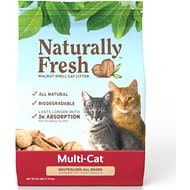
For cats that suffer from cat litter allergies, a natural alternative is often the best choice. Naturally Fresh offers a unique option in the form of cat litter made entirely from walnut shells. This litter offers excellent absorption and strong clumping action to lock away odor and make scooping the litter box a breeze, all without creating unnecessary dust or using artificial fragrance. Naturally Fresh is biodegradable and eco-friendly, completely free from chemicals, toxins, and synthetic additives.
Pros: Made from all-natural walnut shells, strong clumping ability, biodegradable and eco-friendly
Cons: Dark color makes it tough to see dirty vs clean litter
World’s Best Multi-Cat Unscented Clumping Corn Litter
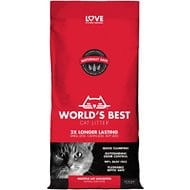
With a name like World’s Best, you’ll have high expectations of this cat litter and they will be met. This formula is all-natural, made from compressed corn rather than clay. It is completely free from silica dust, meaning your cat will breathe easy – it is unscented as well. This corn cat litter forms strong clumps for easy scooping but has the added benefit of being flushable and septic-safe – it’s also surprisingly lightweight. World’s Best cat litter is completely free from artificial fragrance and harmful chemicals.
Pros: Made from all-natural compressed corn, 99% dust-free, flushable clumping formula
Cons: Odor control could be stronger
Okocat Original Premium Wood Clumping Cat Litter
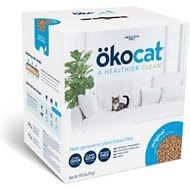
When it comes to plant-based litter, many cat owners complain about inadequate absorption and lack of clumping ability. This Okocat Original Premium Wood litter is unique in that it offers a lightweight, soft texture with strong clumping ability and excellent odor control. Not only is this a great alternative to clay litter for cats with allergies, but it’s good for the environment. This biodegradable cat litter is 99% dust-free and free from chemicals, dyes, GMOs and synthetic fragrance.
Pros: Made from sustainably sourced wood fiber, 99% dust-free, free from artificial fragrance
Cons: Somewhat expensive compared to clay
Yesterday’s News Original Unscented Non-Clumping Paper Litter
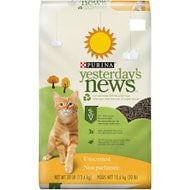
All-natural cat litter can be expensive, but Yesterday’s News offers an affordable and effective solution. This cat litter is made from recycled paper materials which, in addition to being dust-free, are three times as absorbent as clay. Yesterday’s News is completely unscented and eco-friendly but surprisingly tough on odors. What you’ll really love about this litter, however, is the fact that it is extremely low tracking thanks to the unique pellet size. There’s nothing you won’t love about this litter.
Pros: Made from recycled paper, 3 times as absorbent as clay, eco-friendly alternative litter
Cons: Doesn’t form clumps, paper pellets may stay damp
Pioneer Pet SmartCat Unscented Clumping Grass Litter
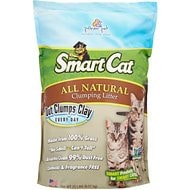
Another natural option for cats with litter allergies is this Pioneer Pet unscented clumping litter made from grass. Available in three sizes ranging from 5 pounds to 20 pounds, this grass-based litter clumps hard and fast for easy scooping and traps odors on contact. It is completely free from irritating fragrances and perfumes as well as 99% dust-free. This cat litter has a smooth, sand-like texture gentle on your cat’s paws and creates a cleaner, healthier litter box for the whole household.
Pros: Made from 100% grass, forms tight hard clumps, 99% dust-free formula, gentle texture
Cons: Odor control could be stronger, lightweight texture tracks to some degree
Dr. Elsey’s Precious Cat Ultra Unscented Cat Litter
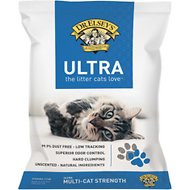
Not only is Dr. Elsey’s one of the biggest names in cat litter, but it’s also one of the most trustworthy brands. This formula is unscented and 99.9% dust-free which makes it an excellent option for cats with allergies. More than that, however, it is extremely affordable and comes in three sizes ranging from 18 to 40 pounds. This clumping clay litter is ideal for multi-cat households because it offers hard-clumping action that locks away moisture and odor while making scooping quick and easy.
Pros: Low dust and low tracking, superior odor control, hard-clumping action, unscented formula
Cons: Fairly heavy, may stick to the bottom of the box
Fresh Step Clean Paws Simply Unscented Clumping Clay Litter
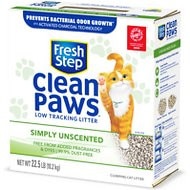
For cats who are sensitive to fragrance, this unscented formula from Fresh Step could be a good choice. Completely free from added fragrance and dye, this 99.9% dust-free formula comes in an 18- and 22.5-pound box. This Fresh Step cat litter features activated charcoal technology which prevents bacterial odor growth while the hard-clumping benefits further help eliminate odor. The anti-microbial formula controls odors for up to 10 days at a time while the larger particle size helps reduce tracking to keep your home clean and tidy.
Pros: Completely free from fragrance and dye, anti-microbial formula, low tracking and 99.9% dust-free
Cons: Wet litter may stick to the bottom of the box
Dr. Elsey’s Precious Cat Respiratory Relief Unscented Non-Clumping Litter
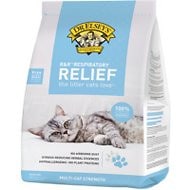
Another popular formula from Dr. Elsey’s, this non-clumping litter is formulated specifically for cats with respiratory issues. This formula doesn’t create any airborne dust and it is hypoallergenic, free from plant proteins, synthetic fragrance, perfume, and dyes. Not only is this litter free from potential irritants, but it contains stress-reducing herbal essences to help keep your cat calm. It traps urine and odor on contact as well, keeping your home smelling fresher for longer.
Pros: Designed for cats with respiratory issues, no airborne dust, free from fragrance and dye
Cons: Doesn’t form clumps, fairly expensive compared to other options
Frisco Multi-Cat Unscented Scoopable Cat Litter
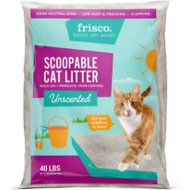
Available in 20-pound and 40-pound bags, this affordable clay litter is unscented which makes it a better option than other clay litters in its price range. This formula is designed for multi-cat households, offering strong odor neutralizing properties with low dust and low tracking. Frisco cat litter is hypoallergenic, free from plant protein, artificial dyes, and synthetic fragrances. Plus, it is made from all-natural clay with a fine texture that’s gentle on your cat’s paws.
Pros: Very affordable price, neutralizes odors on contact, forms hard clumps, easy to scoop
Cons: Fairly heavy litter, only comes in 20-pound and 40-pound bags
Frequently Asked Questions
- Is clay litter bad for cats? When it comes to cat litter, there’s a great deal of controversy surrounding the use of bentonite clay. Clay litter is one of the most affordable options and offers clumping benefits, but it also contains silica dust which can irritate your cat’s respiratory system. Bentonite litter also isn’t particularly good for the environment and it may encourage bacteria to breed in the litter box if it isn’t cleaned often enough. Cats who eat their litter (or accidentally ingest it) may be at risk for intestinal blockage with clay litter because the granules can expand up to 15 times their size when they come into contact with moisture.
- What can cats be allergic to? Cats can develop allergies to a wide variety of substances, just as people can. Other than the fragrances and dust in cat litter, cats can be allergic to ingredients in food, certain fabrics or cleaning products, natural allergens like dust and pollen, even rubber or plastic materials. Cats can also develop an allergic reaction to flea bites or flea control products.
- What can I use as an alternative to cat litter? If your cat develops allergies to common cat litters, one option is to explore alternatives like natural litters made from paper, wood, corn, wheat, or other materials. Another option is to avoid litter entirely by switching to a litter box system that utilizes reusable pellets and pee pads instead of litter granules.
- Can you use rice or oatmeal as cat litter? Dealing with cat litter allergies can be tricky and expensive. If you’re looking for an affordable alternative, you might be thinking about readily available options like rice or oatmeal. While both of these will absorb liquid, they won’t do much to hide the smell of ammonia and they may increase the risk for bacteria and fungal growth if the litter box stays too damp. These alternatives can be used in a pinch but shouldn’t be a long-term replacement for cat litter.
- How often should you change out cat litter? If your cat has allergies to cat litter, it’s important to keep the litter box as clean as possible. Scoop the clumps daily and replace the litter once a week. If you’re able to find a new cat litter your cat doesn’t react to, you may be able to push it back to cleaning out the box every two weeks but daily scooping will always be important to minimize accumulated odor.



